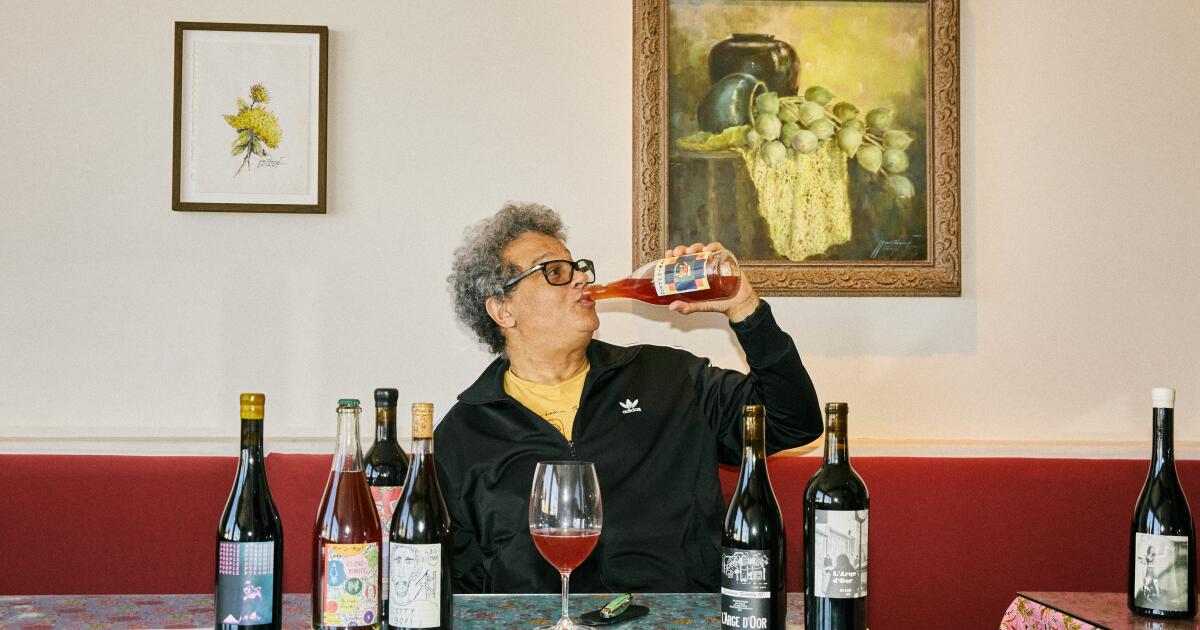
With his nimbus of graying hair and penchant for tracksuit casual, Scott Sampler looks more like an aging deejay than what he is: a winemaker. His wines have landed on the lists of top-end restaurants like Hatchet Hall, Vespertine, Meteora, Anajak Thai and Manuela, where they’re often singled out with sidebars, subsections and narrative intros, declaring, in so many words, “Check this guy out!”
Even in a town like Los Angeles, where the rules for what is and what isn’t cool to drink can be relentlessly, er, fluid, Sampler’s wines have managed to channel L.A.’s boundless culinary enthusiasms for the past decade. Pungent, savory, defiantly unfruity, his wines can be polarizing even in the era of natural wine, when wine’s very range of flavors is in flux.
And yet by their sheer force of personality, idiosyncrasy and restless energy, Sampler’s wines are among the most popular and successful in L.A. right now and feel distinctly of and for this city. An Angeleno by birth, he’s taken a highly developed artistic temperament and a penchant for philosophy and directed these into the medium of winemaking.
“He goes deep,” says Anajak Thai’s wine director Ian Krupp, who’s worked with Sampler’s wines and has collaborated on restaurant-only exclusives. “He doesn’t really have any boundaries for himself.”
Sampler has three distinct wine brands. There’s Scotty-Boy! (exclamation his), perhaps his most visible and accessible, with arcane names like “Big Tang” and “El Sandweech!!!” They’re often blends of grape varieties that really have no business being in the same bottle, like Chardonnay and Riesling, with varying levels of skin contact, co-fermentation, carbonic ferments or pétillance.
Wines from the other two brands, CCGP (Central Coast Group Project) and L’Arge d’Oor (see what he did there?) might be construed as more serious, with long periods — as much as 12 years — in barrel and bottle before release.
His latest endeavor, Cahiers du Oenologique (“winegrowing notebooks”), is a joint project with his high school friend, filmmaker Babak Shokrian. They’ll release an estate wine in the fall from Shokrian’s vineyard in Los Alamos, supplemented with art materials, short films, photos and a quarterly journal documenting the process as it went from harvest to bottle. “We’re going to be exploring the auteur theory of winemaking,” says Sampler.
Taken together, his wines flirt with the flavors associated with natural wines — sour, slightly grubby, jangly and volatile, flavors sometimes more common in kombucha than wine, ranging from serious to “chuggy.”
That range, and that vibe, attracts people to him, especially sommeliers, like Nathaniel Muñoz, former wine director at the Rose Café in Venice. “Scott chooses to approach winemaking,” he says, “in a way that challenges most people’s thinking about what you can do to grapes that will become wine.”
‘I dove right in’
On a recent Thursday, Sampler was ensconced in a booth across from the bar at Musso & Frank’s in Hollywood. He likes to say that his first meal at Musso & Frank’s was in utero. “My parents used to come here before I was born,” he tells me. “By the time I was seven I was a regular.”
Over his Musso & Frank favorites — lightly grilled prime rib, sand dabs, creamed spinach, mashed potatoes, apple pie à la mode — he discussed how it all started.
“I had absolutely no thought of making wine until it started to happen,” he says. “These abstract ideas I kept having around winemaking started to coalesce, they started to become a tangible thing. The path appeared, all the doors opened and I dove right in. Damn the torpedoes!”
Sampler was born in Los Feliz; his love of food and wine comes from his parents, who pushed him in an artistic direction early on. His mother, Georgianna, was an actress who flourished, for a time, in the orbit of Roger and Gene Corman movies before settling into a career teaching library science. Sampler’s father, Marion, worked for the architects Gruen Associates, the first Black designer at that firm.
His dad collected wine, mostly Italian, back when that country’s top reds — Barolos and Amarones among them — were more provincial in their flavors, prone to tactile tannins and a propensity for volatile complexity with age. Sampler snuck bottles out of his dad’s cellar. Those wines, and their idiosyncratic flavors, were the ones that shaped his palate.
After getting a degree in philosophy at UC Berkeley, Sampler came back to L.A. He worked in the film industry trenches for several years — he was Quentin Tarantino’s personal assistant for “Reservoir Dogs,” while pursuing acting, writing and photography. In the late aughts, after a bad breakup, he planted a vineyard in the Malibu hills with a friend who had a few acres to contribute. (“I was looking for forms of escape besides the long walks on the beach,” he says.) The project was abandoned, but the following year, Sampler founded CCGP.
‘Low and slow’
Sampler’s love for Italian food and wine took him in the direction of the Slow Food movement. His original intention was to make slow wine in the spirit of what made slow food slow — purist, artistic, traditional methods.
It’s a common practice among artisan winemakers to extend a future wine’s contact with skins before being pressed off and sent to barrels or tanks. That extra maceration time can give the wine more color and texture. It’s hard to generalize, but that period rarely exceeds forty days.
But in Sampler’s Buellton winery, crushed grapes can lie in repose in bins and barrels, macerating, fermenting slowly on ambient yeasts, untouched for a hundred days or more before being pressed off — up to four times longer than your typical maceration period.
Then the CCGP wines will sit for another five, eight, 10 years, depending on whether Sampler thinks the wine starts to feel “interesting.” The current vintage for most of the CCGP reds is 2014. “It’s like making a sauce: take the best ingredients and work with them, low and slow, so they take on more depth with time.”
L’Arge d’Oor wines have a shorter élevage, with aging regimes closer to three years — still years longer than most conventional bottlings.
Both the CCGP and L’Arge d’Oor wines are fiercely savory and vinagrous, often smelling of mushrooms and turned earth and woodsmoke: They can seem not so much natural as denatured, stripped of one thing to reveal another. The approach is deliberative — when you leave something alone, you are still changing it. “I guess I have sort of a deconstructive personality,” he says.
But his intention is a far cry from neglect. “It’s like Jiro Dreams of Sushi,” he says, referring to David Gelb’s 2011 movie about the sushi master Jiro Ono. “Jiro is buying the same fish as other sushi chefs … but all of the energy and the aesthetic and the choreography, all the intention, the gestalt he puts into it makes his sushi better. Whatever that is, it is a thing, an ingredient, and it comes from the people who make it.”
That’s what Sampler aims to instill in the CCGP wines. “I want to make it available to all of your senses,” he says.
Muñoz, who for years sold Sampler’s wines at the Rose Café, has felt a mixture of skepticism and respect for the project, the man and the wave he’s riding.
“When he first came to me I was like, ‘These wines aren’t correct,’” says Muñoz. “They were volatile, sharp and sour tasting, they felt unsound and unkempt.
“‘No one will buy a wine with this many flaws,’ I told him.” But it didn’t seem to faze Sampler. “He was just like, ‘Can I bring you something else?’” The next year Muñoz bought a number of the wines.
Muñoz was acknowledging, too, how the drinks world was becoming more accommodating of extreme flavors, even in wine. “The generation after me grew up in a world where kombucha on tap and sour beer’s a thing and people do vinegar shots,” he says. “They’re okay with volatility, lactic weirdness, beer taint flavors, all these things you wouldn’t have in classical wines; these register as normal to their palate.”
The approach, where wines languish in the cellar on their way to becoming sauce, can leave one with nothing to sell for years at a time. Scotty-Boy! was conceived as both a COVID diversion and a financial necessity. The wines are inexpensive to produce, ready to release mere months after they’ve been made, and fun to drink on repeat. In a town that’s gaga for glou-glou, they lit a spark.
The range of flavors afforded by these three tiers provides an unexpected versatility on restaurant menus. Wine director James Saidy used Sampler’s wines at Meteora and Vespertine in pairing menus, complementing chef Jordan Kahn’s eccentricities with exotic precision. “Scotty-Boy! wines are more like watercolors,” he says. “The CCGP wines are more along the lines of an oil painting. They’re like time capsules, built around a place.”
For a time at Anajak Thai, Krupp employed a Scotty-Boy! house wine that flew off the shelves while it lasted. “It was this skin-contact carbonic Riesling,” says Krupp. “Full skin-contact is rare in Riesling; carbonic maceration is unheard of.” But the wine turned out to be a jack-of-all-trades. “We could pair with almost any dish,” says Krupp, “with crudo, because it had citrus notes, with curry custard and ginger, even with a steak because it had all this texture. The wine made all the flavors pop.”
During COVID, Krupp would visit Sampler at his winery, where the full measure of his personality, what went into the wines, was revealed to him. “Mostly we’d talk about jazz or films or philosophy, or we’d joke around. He’s a really funny guy.”
Conversations with Sampler often veer away from Muscat and toward Marcel Duchamp, Jacques Baudrillard, David Hockney, Don Cherry, Serge Gainsbourg, electric Miles, acoustic Dylan. (Sampler’s border collie is named Serge, for the late French chanteur.) If Sampler had a mood board on his winery wall, icons like these might be on it, alongside bottles of Clape Cornas, Gravner’s Rosso, and Barolos from Oddero and Rinaldi.
Sampler likes to think that there was always room at the table for him — he just needed to step into the role. “I mean, I’ve always loved fine dining,” he says. “The reason I go to restaurants is to have dishes I’ve never experienced … trying something I wouldn’t know what it was unless somebody told me about it.”
That’s what makes dining, and wine, move forward. “I don’t think wine should be a monolithic thing,” he says. “Otherwise there’s never any progress, right?”



